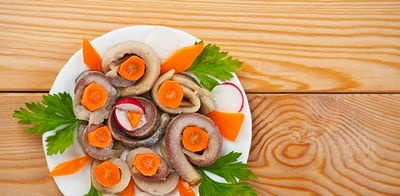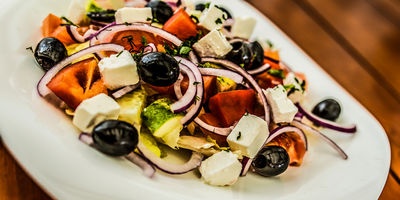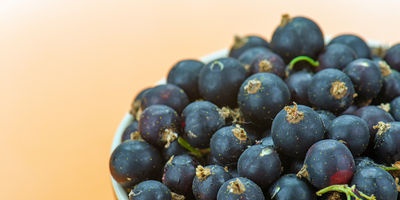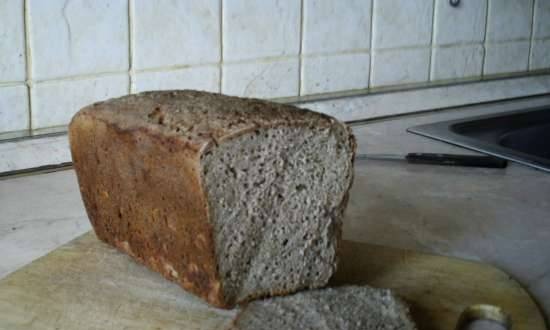|
 Proteins, fats, carbohydrates, mineral salts, vitamins, water ... Our body consists of them, our food also consists of them. Proteins, fats, carbohydrates, mineral salts, vitamins, water ... Our body consists of them, our food also consists of them.
In order to eat properly, it is important to choose food of such composition so that it provides the body with all the necessary nutrients. With food, a person should receive over 60 different nutrients, many of which are irreplaceable. And the lack and excess of one or another food substance in food can adversely affect health.
It turns out that you can "get poisoned" by excessive use of ... water. So, if in the heat a person drinks a lot of liquid at once, this can lead to nausea, poor health and even seizures. In the past, until people knew the correct drinking regime, this condition sometimes occurred among workers in hot workshops.
The main nutrients should be balanced in the diet, that is, they should be not only in sufficient quantities, but also in certain ratios among themselves. Thus, the most favorable conditions for the work of the digestive system and for good assimilation of food are created when the ratio of the amount of proteins, fats and carbohydrates in the daily diet is 1: 1 - 4-5.
Foods are a complex mixture of different nutrients. In nature, however, there is not a single product that could satisfy all the body's needs for nutrients. Each product, depending on its chemical composition, can only more or less satisfy these needs. Therefore, the most important condition for proper nutrition is its diversity.
In order to ensure a favorable combination of various nutrients in the diet, the creation of new high-grade food products has been repeatedly proposed. The famous Soviet scientist A.E.Sharpenak proposes the enrichment of such a popular product as bread with complete protein. Thus, adding skim milk (milk processing product) to the dough is a very expedient and cheap way to improve the nutritional value of bread, especially rye bread. From the point of view of a balanced diet, the Belip product developed by the Institute of Nutrition of the Academy of Medical Sciences is beneficial. Belip is a mixture of fish and cottage cheese, contains valuable amino acids, mineral salts and essential fatty acids. This product is mastered by the food industry and goes on sale. You can cook many tasty and healthy dishes from it: cutlets, meatballs, pate, pies, etc.
 A variety of food also increases the digestibility of individual nutrients, and therefore the biological and nutritional value of the diet. So, the assimilation of proteins is significantly increased in the presence of vegetables in the diet. Conversely, excess fat reduces the absorption of food, especially protein. Food that is monotonous in composition and taste is inferior, besides, it quickly gets bored, as they say, "bored", impairs appetite, is digested and absorbed worse. A variety of food also increases the digestibility of individual nutrients, and therefore the biological and nutritional value of the diet. So, the assimilation of proteins is significantly increased in the presence of vegetables in the diet. Conversely, excess fat reduces the absorption of food, especially protein. Food that is monotonous in composition and taste is inferior, besides, it quickly gets bored, as they say, "bored", impairs appetite, is digested and absorbed worse.
Many, however, as the study of the population's nutrition shows, are little aware of the nutritional value of certain foods and dishes and are usually guided in their choice only by their tastes and habits, as a result of which they eat insufficiently varied.
The improvement in the well-being of the population has led to the preferred consumption of meat and meat products, animal fats. Often, due to the preserved traditions, the proportion of bread products, cereals and flour products in the diet is still too large. Many people are immoderate in their consumption of sweets, especially sugar and confectionery products containing a lot of fat.
Therefore, we will not "campaign" for meat, bread, cereals, flour food, animal fats, sugar, confectionery and sweets, which are already quite popular and occupy a large (sometimes excessively large!) place in our diet.
At the same time, as studies show, due to lack of awareness, milk and dairy products, vegetables and fruits, herbs, berries and melons, fish, vegetable fats, legumes (peas, beans and etc.).
Milk is often regarded not as a food product, but as a drink or as a product, but mainly for baby food. Therefore, not everyone still consumes milk systematically and in sufficient quantities.
Meanwhile, milk is one of the most important human food products. Milk and dairy products add variety to nutrition, improve taste, and increase the nutritional value of food.
Noting the exceptional importance of milk in human nutrition, I.P. Pavlov called it food prepared by nature itself.
Milk is an indispensable product for improving the protein composition of food, for enriching it with complete fats, essential mineral salts and vitamins, trace elements, enzymes and hormones.
No food product contains as many and important elements vital for a person as there are in milk. Milk contains about 100 different substances, including: 20 amino acids, about 20 fatty acids, 4 types of milk sugar, more than 20 vitamins, dozens of mineral salts, enzymes, hormones, etc.
Milk and dairy products are easy to digest, almost completely absorbed and leave very few "toxins" in the body. It is important to note that “milk of all requires the least strength for its assimilation” (IP Pavlov). So, for the assimilation of the proteins it contains, 3-4 times less consumption of digestive energy is required than for the assimilation of, for example, bread; while the digestibility of milk proteins is higher than the digestibility of bread proteins.
 Especially important is the presence in milk of nutrients that play a significant role in the prevention of atherosclerosis: vitamins A, C, E, group B, choline and methionine. Especially important is the presence in milk of nutrients that play a significant role in the prevention of atherosclerosis: vitamins A, C, E, group B, choline and methionine.
In our country, in a number of republics, in addition to cow's milk, the milk of a goat, sheep, buffalo, camel, mare, donkey, and female yak is widely used in nutrition.
Milk is used to prepare such valuable food products as powdered and condensed milk, cream, cheeses, various lactic acid products - cottage cheese, curdled milk, kefir, koumiss, acidophilus and etc.
According to its biological properties and nutritional value, powdered milk is a full-fledged substitute for fresh milk. Many, unfortunately, neglect it in vain. The reconstituted milk does not need to be boiled. This makes it easier to use it on camping trips, on expeditions, etc.
Obtained by fermenting milk with lactic acid bacteria or fungi, lactic acid products with their refreshing pleasant sourish taste increase appetite, quench thirst, have a beneficial effect on the liver, reduce and suppress putrefactive and fermentative processes in the intestines.
The name "kefir" comes from the Turkish word "keif", which means pleasure, pleasure, and also from the word "kef" - health. Ayran is an original and tasty lactic acid product. “He who drank ayran was saved,” says a Kyrgyz proverb.
Cottage cheese and cheese are very valuable dairy products. Curd has a beneficial effect on fat metabolism, is easily digested and absorbed. Many delicious and nutritious hot and cold dishes can be prepared from cottage cheese. Cottage cheese can be combined with vegetables and fruits (for example, carrot and curd dishes, puddings, cereals, etc.). Cheese is rich in complete proteins, easily digestible fat, mineral salts, especially calcium and phosphorus, vitamins A, B1, B2, PP. About 80 different types of cheese are produced in our country.
Milk and dairy products are not only complete and healthy food themselves, but also help to increase the digestibility of other products with which they are combined. However, milk and dairy products are still extremely inadequate in our diet in the range of dishes prepared from them. So, they are almost never combined in the cooking process with vegetables and fruits, cereals and fish, as well as with other products.
 As the only food for a child in the early stages of his life, milk should also be included in the diet of an adult, especially an elderly person. According to the English scientist John Shane, a person should die on the same diet that he entered into it. As the only food for a child in the early stages of his life, milk should also be included in the diet of an adult, especially an elderly person. According to the English scientist John Shane, a person should die on the same diet that he entered into it.
Milk and dairy products are extremely useful for people of all ages, are available at any time of the year, and should become an obligatory part of every family's daily menu.
Fresh vegetables, fruits, berries and greens contain about 85-95% water. And since plant food contains few nutrients, low-calorie, it, in the opinion of many, is not essential in nutrition.
Therefore, studies show that little is still consumed, vegetable snacks, vegetarian soups, second vegetable dishes; flour and cereal side dishes are often preferred to vegetable side dishes, and combined vegetable side dishes are especially rare on the menu.
Despite the wide range of possibilities, as a rule, the range of consumed vegetables is very limited: these are mainly potatoes, cabbage, tomatoes, onions, carrots, beets; many almost never use turnips, zucchini in their diet, pumpkin, rutabagas, eggplants, corn, legumes, some types cabbage (Brussels, etc.); housewives for some reason underestimate the importance of different herbs: lettuce, parsley, celery, dill, etc.
Plant food is the only source of many substances that are extremely important for the body that are not found in other foods. So, practically only from these products the body receives vitamins C and P; only with vegetables and fruits does carotene enter the body, which in the body turns into vitamin A.
Vegetables and fruits complement other foods as sources of vitamins B1 and B2, PP and K; contain a lot of folic acid, which contributes to the formation in the body choline - a substance that regulates fat metabolism.
Vegetables and fruits supply us with many minerals (including trace elements): compounds of calcium, phosphorus, magnesium, iron, manganese, etc. Some, for example potassium salts, enter the body mainly with vegetables, fruits and berries.
Vegetables and fruits contain almost no fat (The exception is legumes and nuts; legumes contain up to 2% fat, and nuts up to 25-27%.). At the same time, the tartronic acid contained in vegetables inhibits the conversion of carbohydrates into fat. Raw vegetables are especially useful (after heat treatment, tartronic acid loses its activity): they limit the formation of fat in the body and reduce its deposition. Raw vegetables are also useful because some of the vitamins and mineral salts they contain are lost during the cooking process.
There are few proteins in vegetables (except for legumes), about 1-2%. However, in some (for example, cabbage and potatoes), essential amino acids are found in favorable ratios for our body.
The ballast substances contained in vegetables and fruits - fiber and pectin - contribute to the normal functioning of the intestines and the elimination of significant amounts of cholesterol from the body.
By their chemical composition, different types of vegetables differ significantly from each other. For example, potatoes are very rich in starch, green peas - in protein, onions and garlic - in phytoncides, and dill - in aromatic substances; at the same time, different varieties of the same type of vegetables differ significantly in their nutritional value - in the content of vitamins and minerals: for example, different varieties of cabbage differ significantly in the content of vitamin C, red carrots are richer in carotene than yellow ones. Therefore, the more diverse the assortment of vegetables, fruits, berries and herbs, the better the body is supplied with vitamins, mineral salts, organic acids and other nutrients contained in plant foods.
 Vegetables and fruits are valuable not only in and of themselves as sources of vitamins and mineral salts, trace elements and fiber, but also because they have a beneficial effect on metabolism and promote better digestion and absorption of nutrients. This is due to their ability to significantly increase the secretion of digestive juices and enhance their enzymatic activity. So, for example, proteins of food, consisting of meat, cereals and bread, are absorbed on average by 75%. If at the same time part of the bread and cereals is replaced with various vegetables, then 85-90% of proteins will be assimilated. Vegetables and fruits are valuable not only in and of themselves as sources of vitamins and mineral salts, trace elements and fiber, but also because they have a beneficial effect on metabolism and promote better digestion and absorption of nutrients. This is due to their ability to significantly increase the secretion of digestive juices and enhance their enzymatic activity. So, for example, proteins of food, consisting of meat, cereals and bread, are absorbed on average by 75%. If at the same time part of the bread and cereals is replaced with various vegetables, then 85-90% of proteins will be assimilated.
Vegetables and fruits not only diversify our food and improve its taste, but also decorate our table, play a certain aesthetic role in nutrition.
These are the various qualities of vegetables and fruits that make them an essential part of the food of every person.
Vegetables and greens should be eaten every day throughout the year. We must try to ensure that fresh vegetables are included in the diet at every meal; and some of them are raw. As appetizers and light breakfasts, all kinds of vegetable salads should be included in the daily menu. So, radishes, tomatoes, fresh cucumbers, green onions, raw carrots, grated before serving, with sour cream are good, mayonnaise... In winter and spring, you can use sauerkraut for preparing salads, as well as various canned vegetables: green pea, carrot, beets, etc.
The menu should often include vegetarian (vegetable and fruit) soups. Borscht and soups are good for cooking with vegetable broths. In the summer, many people prefer to eat cold soups: okroshka, beetroot with fresh cucumbers, fruit soups. Milk soups with vegetables are nutritious and tasty.
More often it is necessary to include in the menu all kinds of vegetable dishes: cook stews, cabbage rolls, various casseroles from vegetables. A delicious second dish can be prepared from corn, green peas. Useful and affordable products that allow you to diversify the assortment of vegetable dishes are eggplant, zucchini, pumpkin, rutabaga.
We must try to add vegetables to any dish: more often prepare vegetable side dishes, especially combined ones. So, for example, sauerkraut is good to combine with potatoes, beets, carrots.
In winter and early spring, vegetables, herbs, fruits and berries are less available and their assortment is not so diverse. In addition, with long-term storage, the amount of vitamins in them decreases significantly. Therefore, it is important to take care of preparing them for future use by fermentation, salting, pickling, drying, canning.
Vegetables and fruits are useful at any age and should be included in the daily diet of every person in different forms all year round.
In the diet of most people, it still occupies a very modest place fish... In canteens, for example, fish dishes are chosen 4-5 times less often than meat ones. Many people eat fish only a few times a month, mistakenly considering it a light and "unhealthy" food. Some, not wanting to "bother" with fresh fish, eat only salted fish (herring, sprat and others), smoked or canned. Others do not tolerate the peculiar "sea" smell of some fish species and, not knowing the various culinary methods of processing fish, they hardly use it in their home meals.
 Meanwhile, fish and products prepared from it are a rich source of complete protein, mineral salts and some vitamins (A, B12, etc.). Fish meat is rich in microelements (fluorine, copper, etc.). Saltwater fish, for example cod, flounder, sea bass and others, contains iodine, which has a beneficial effect on cholesterol metabolism and plays a role in preventing atherosclerosis... Fish (except small - sprats, sardines, sprat) significantly less meat contains so-called purine bases, i.e., compounds from which uric acid is formed. It is known that deposits of uric acid salts in joints, cartilage and tendons lead to gouty symptoms, especially in old age. There are very few purines in the cod. Meanwhile, fish and products prepared from it are a rich source of complete protein, mineral salts and some vitamins (A, B12, etc.). Fish meat is rich in microelements (fluorine, copper, etc.). Saltwater fish, for example cod, flounder, sea bass and others, contains iodine, which has a beneficial effect on cholesterol metabolism and plays a role in preventing atherosclerosis... Fish (except small - sprats, sardines, sprat) significantly less meat contains so-called purine bases, i.e., compounds from which uric acid is formed. It is known that deposits of uric acid salts in joints, cartilage and tendons lead to gouty symptoms, especially in old age. There are very few purines in the cod.
Fish products have a lower calorie content than meat products (this explains the not so quick possibility of saturation with them) due to the relatively low percentage of fat in most fish varieties. However, fish oil contains significant amounts of vitamin A, as well as polyunsaturated essential fatty acids.
Low-fat varieties of fresh fish (carp, carp, navaga, pike and others) are digested in the stomach and intestines faster than meat. Fresh fish meat is absorbed by 92-98% and almost does not give a feeling of heaviness in the stomach.
Fish can be used to make a wide variety of nutritious and delicious dishes. It is good to eat fish jellied or stuffed (cod, zander, perch, pike), boiled or fried in vegetable oil, as well as in the form fish cakes, fish dumplings, fish soufflé.
It is recommended to use milk and dairy products to improve the taste of fish when cooking it. Some varieties of fish are boiled in milk, cooked milk soups with fish... Sour cream and milk sauce is very good for many fish dishes.
There is an opinion that the combination of fish dishes with dairy dishes causes intestinal upset. However, as Professor M.S.Marshak points out, the point is not the incompatibility of these products, but the fact that some people do not tolerate whole milk well. It is known that approximately 3% of the world's adult population is intolerant of whole milk, as it only causes them digestive upset.
It is necessary to use more often not only fish and fish products in the diet, but also seafood: seaweed, scallops, trepangs, mussels and etc.; they contain complete proteins, some vitamins and a rich set of valuable microelements. This will help make meals more varied and more complete.
Thanks to the improvement in the well-being of our people, people are introducing more and more animal fats into their diet. At the same time, cheaper but necessary vegetable oils are used very insufficiently.
Many, as studies have shown, consider vegetable fats to be inferior and either do not use them at all, or use them very rarely.
The underestimation of vegetable fats is associated with the idea, which has taken root until recently, that vegetable fats are deprived of some components (vitamins, etc.), which are rich in animal fats, and therefore are, as it were, "second-class" fats.
However, in recent years, when studying the effect of different fats on the human body, the great importance of polyunsaturated essential fatty acids, some fat-soluble vitamins, phosphatides and phytosterols contained in vegetable fats has been established.
Recent scientific studies have established that a lack of highly unsaturated fatty acids (they are called vitamin F) in food leads to a decrease in the body's resistance to various adverse influences, contributes to the occurrence of cardiovascular diseases and various metabolic disorders.
 Food rich in vegetable fats lowers blood cholesterol and thereby helps prevent the development of atherosclerosis. Unrefined vegetable oils (with the exception of cottonseed) are especially useful. Food rich in vegetable fats lowers blood cholesterol and thereby helps prevent the development of atherosclerosis. Unrefined vegetable oils (with the exception of cottonseed) are especially useful.
Vegetable fats can be used for making sauces, dough products, dressing salads, vinaigrettes, snacks, and frying potatoes. The use of vegetable fats allows the inclusion of fish in the menu (for frying, herring dressing, etc.).
It is known that high quality vegetable fats are used to make margarine. Therefore, margarine, which combines fats and animal and vegetable, can be considered a product even more complete than butter.
It is desirable to use two-thirds of animal fats and a third of vegetable fats in the diet. Vegetable oils must be eaten at any age, every day, all year round.
More often than many others do, legumes (peas, beans, etc.) should be included in the diet.They are rich in complete proteins, fats containing unsaturated fatty acids, certain vitamins and mineral salts. They can be consumed in the form of green beans and peas, as well as a wide variety of concentrates and canned foods.
We stopped only at those products that are either undeservedly forgotten by many, or underestimated. As a result, health is damaged.
Which of the products is especially useful? What to give preference to - meat, fish, milk or vegetables?
A healthy person is "omnivorous": there are no harmful products for him, except for poor quality and poisonous ones. The completeness and high quality of food is achieved by the wide use of a wide variety of products, but their quantity must be correctly dosed.
Therefore, one must remember the basic rule: one should neither get carried away excessively, nor neglect any products - one must eat everything, but in moderation.
L. V. Baranovsky - 5 mistakes in our diet
|
 Proteins, fats, carbohydrates, mineral salts, vitamins, water ... Our body consists of them, our food also consists of them.
Proteins, fats, carbohydrates, mineral salts, vitamins, water ... Our body consists of them, our food also consists of them. A variety of food also increases the digestibility of individual nutrients, and therefore the biological and nutritional value of the diet. So, the assimilation of proteins is significantly increased in the presence of vegetables in the diet. Conversely, excess fat reduces the absorption of food, especially protein. Food that is monotonous in composition and taste is inferior, besides, it quickly gets bored, as they say, "bored", impairs appetite, is digested and absorbed worse.
A variety of food also increases the digestibility of individual nutrients, and therefore the biological and nutritional value of the diet. So, the assimilation of proteins is significantly increased in the presence of vegetables in the diet. Conversely, excess fat reduces the absorption of food, especially protein. Food that is monotonous in composition and taste is inferior, besides, it quickly gets bored, as they say, "bored", impairs appetite, is digested and absorbed worse. Especially important is the presence in milk of nutrients that play a significant role in the prevention of atherosclerosis: vitamins A, C, E, group B, choline and methionine.
Especially important is the presence in milk of nutrients that play a significant role in the prevention of atherosclerosis: vitamins A, C, E, group B, choline and methionine. As the only food for a child in the early stages of his life, milk should also be included in the diet of an adult, especially an elderly person. According to the English scientist John Shane, a person should die on the same diet that he entered into it.
As the only food for a child in the early stages of his life, milk should also be included in the diet of an adult, especially an elderly person. According to the English scientist John Shane, a person should die on the same diet that he entered into it. Vegetables and fruits are valuable not only in and of themselves as sources of vitamins and mineral salts, trace elements and fiber, but also because they have a beneficial effect on metabolism and promote better digestion and absorption of nutrients. This is due to their ability to significantly increase the secretion of digestive juices and enhance their enzymatic activity. So, for example, proteins of food, consisting of meat, cereals and bread, are absorbed on average by 75%. If at the same time part of the bread and cereals is replaced with various vegetables, then 85-90% of proteins will be assimilated.
Vegetables and fruits are valuable not only in and of themselves as sources of vitamins and mineral salts, trace elements and fiber, but also because they have a beneficial effect on metabolism and promote better digestion and absorption of nutrients. This is due to their ability to significantly increase the secretion of digestive juices and enhance their enzymatic activity. So, for example, proteins of food, consisting of meat, cereals and bread, are absorbed on average by 75%. If at the same time part of the bread and cereals is replaced with various vegetables, then 85-90% of proteins will be assimilated. Meanwhile, fish and products prepared from it are a rich source of complete protein, mineral salts and some vitamins (A, B12, etc.). Fish meat is rich in microelements (fluorine, copper, etc.). Saltwater fish, for example
Meanwhile, fish and products prepared from it are a rich source of complete protein, mineral salts and some vitamins (A, B12, etc.). Fish meat is rich in microelements (fluorine, copper, etc.). Saltwater fish, for example  Food rich in vegetable fats lowers blood cholesterol and thereby helps prevent the development of atherosclerosis. Unrefined vegetable oils (with the exception of cottonseed) are especially useful.
Food rich in vegetable fats lowers blood cholesterol and thereby helps prevent the development of atherosclerosis. Unrefined vegetable oils (with the exception of cottonseed) are especially useful.









